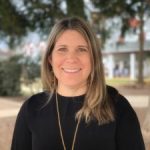Nation’s skeletal school mental health network will be severely tested
In February 2020, Caden McKnight was elected student body president of his high school in Las Vegas.
A year later he was in his room, attending a Zoom meeting of the Clark County School District Board of Trustees, pleading with board members to reopen the district’s schools.
Just being together in person and having a normal routine, Caden said, would help kids cope with mental health struggles. He told the board members about his own grief, over the death of his friend, Mia, who died just after Valentine’s Day this year from an accidental drug overdose.
“I knew her since I was 11,” he said of Mia, who had been his date to a homecoming dance. “I grew up with her and she got to see me grow up. It’s tough as a 17-year-old kid when these people around me are dying. I love my family, but I have no outlet to express how I’m feeling the way I used to when I was at school with teachers and friends.”
From loneliness and anxiety to severe or suicidal depression, the coronavirus’ mental health impact on youth has surged into its own epidemic, swelling the number of children’s visits to emergency rooms for mental health problems. National screenings show that children, adolescents and teens have struggled emotionally during the pandemic more than any other age group. More than one-third of teen girls and one-fifth of teen boys have new or worsening anxiety, according to a January poll by the C.S. Mott Children’s Hospital in Michigan.
But as waves of young people return to school, the system of mental health supports that await them remains patchy and overburdened.
As of 2018, each of the 37,000 school psychologists in the U.S. was responsible for an average 1,200 students, nearly double the recommended number. In some school districts, one psychologist is responsible for as many as 3,000 students, according to the National Association of School Psychologists.
“If we don’t address those non-cognitive factors, they won’t succeed academically, which is ultimately what we are held accountable for.”
Ralph Aiello, director of school counseling for Broward County Schools in Florida
The nation’s 43,000 school social workers were responsible for, on average, 1,200 students each, in 2018, according to data from the U.S. Bureau of Labor Statistics. That’s nearly five times the recommended ratio of 1-to-250. And millions of students attend schools where there is no social worker or psychologist.
School mental health providers are in critically short supply for two reasons: There aren’t enough training programs for those interested in entering the field and those who do obtain credentials can earn more as in the private sector.
Mental health providers are also concentrated in cities. In rural areas of the country, districts often can’t fill open positions and are beginning to opt for connecting students with practitioners by video.
Experts, including Robert Boyd, president and CEO of the School-Based Health Alliance, also worry that most providers are white women. Especially needed, he said, are pathways for young people of color to become licensed and certified mental health providers without accumulating massive debt.
“It’s best to have practitioners who can relate to the students,” said Boyd, whose organization is working to expand programs focused on recruiting middle and high school students into the field.
But that approach, Boyd concedes, will take at least a decade to make any kind of dent.
No state in the country meets the recommended ratio of 250 students per social worker. Washington, D.C. came the closest, at 365, as of 2016. Pay is a factor. A school social worker in Washington, D.C. made over $70,000 in 2018, the highest rate in the nation. Their peers in high-rent California made less than $60,000.
1,200 — the number of students, on average, for which a psychologist in America’s public schools is responsible
Many districts, even while under pressure to accelerate learning, are adding behavioral health programs as they reopen schools. In some cases, this means flipping the way students receive help from the traditional referral-based system to proactive outreach. Social workers are calling students who they have seen before to ask how they are doing and using surveys to assess other students for signs of distress.
“They may not understand how to reach out, so we are reaching out,” said Terrilyn Rivers-Cannon, a social worker at Booker T. Washington High School in Atlanta. “We have to be careful and ask, ‘Is everything ok?’ We massage the conversation from there and then find out about the sleepless nights.”
And once they start talking, many kids are more open than they were before the pandemic. In general, said Rivers-Cannon, youth and parents who never would have spoken about emotional issues are more comfortable sharing.
“We do have cultures that are not willing to discuss it, and that’s OK,” she said. “We come in and provide information that everyone, at some point, can relate to. Then they may reach out and say, ‘Yes, I need the help.’”
Related: Parents fighting, teachers crying — Grownup stress is hitting kids hard
Many states are rethinking their lack of investment in student mental health. While it won’t address the workforce shortage, retooling state Medicaid plans could generate millions of dollars, enabling districts to add more mental health providers. Most states have typically restricted the use of Medicaid funds in the schools to services for students eligible for special education. Eleven states recently amended their laws to allow school social workers and psychologists to bill for time they spend with any Medicaid-enrolled student.
For example, when Michigan lawmakers expanded the state’s list of Medicaid-eligible services, districts were able to hire additional masters-level psychologists and behavioral health analysts. The state projects an increase of $14 million in funds for school-based mental health services, resulting solely from being allowed to bill Medicaid for the services of psychologists. Eight other states are either considering the same change or are in the process of doing so.
Most young people have experienced what experts call “disenfranchised grief” — the sadness and irritability of missing out on life, with no return to normal in sight, coupled with a sense that such feelings don’t rate attention when other people have lost loved ones.
Over the winter, when coronavirus cases spiked in the Bay Area, the isolation of remote learning got really hard for Aurora, an eighth grader in Oakland. To protect her privacy, Aurora gave her middle name and asked that her last name not be used.
“Every single day of my life has been the same for almost a year,” she said. “It drags you down after a while.”
Aurora began feeling depressed and disconnected during the winter, partly due to all the time she was required to spend staring at a screen on Zoom. Paradoxically, the internet provided a solution to her sadness when she met a 14-year-old German girl in an online chat forum. That new friendship helped her feel “heard and needed.”
But when school reopens, Aurora said, she doesn’t want to spend a lot of time in class talking about how she feels.
133 — the number of social workers for the more than 320,000 students in the Clark County School District in Nevada
“If I’m going to be completely candid, schools and teachers and administrators can do nothing to affect how comfortable I feel,” she said. “What schools can do is make interesting curriculum and give us time to talk to our friends, who are going through the same things.”
The type of sadness Aurora experienced, over missed social gatherings and other everyday things, can be easy to minimize, said Kathleen Minke, executive director of the National Association of School Psychologists.
“Kids will look at those things and grieve their losses, but they’re not the same as the friend whose dad died,” she said, and that can lead to guilt layered on top of grief. Ignoring such feeling can lead to problems later on.
Related: How one school is coping with mental health — Social workers delivering technology, food and counseling to kids at home, and open office hours all day — even when school is out
Experts say that most kids will respond positively to two things that schools provide naturally: routine and friends. Few age groups are as developmentally social as teenagers; being able to safely return to typical peer group interactions may be all some kids need. Others will need more support, but even though schools are required to provide it, they don’t always do so.
Just over a year ago, in the early days of the pandemic, Caleb George, 16, thought he was coming down with a cold. The next week, his school in Oakland went into lockdown. A couple of weeks later, he and his mom were diagnosed with the coronavirus.
After that, they were on their own. Quarantined at home, Caleb tried to keep up with school but he had migraine headaches, severe fatigue and mental fog — symptoms that got worse when he looked at a computer screen. Months later, after suffering through a summer relapse, Caleb found out he was a “long-hauler.”
“I got into this cycle where I felt really bad or I avoided school and my grades started dropping,” Caleb said. “Then my mental health was even worse.”
He and his mom asked the school district for accommodations, but neither of them felt that Caleb got what he needed.
“My school didn’t understand how severe it was,” Caleb said. “They offered mostly just small accommodations. What I needed was to not do Zoom meetings.”
Caleb maintained a select few friendships during remote learning, growing closer to his closest friends. He and his mom supported one another, making each other tea and toast, taking turns walking their dog up the block and back, but he missed making new friends and just being around other kids.
“I love my family, but I have no outlet to express how I’m feeling the way I used to when I was at school with teachers and friends.”
Caden McKnight, 17
Many other young people, whether or not they contracted the virus, describe the same bleak feeling of missing out on life and not knowing when, if ever, things will ever be normal again.
“I’m a really social person,” said Amelia Harris, a senior at Burlingame High School in Burlingame, California. “In school, I’d have these little side conversations. Now, I have three close friends. There are all these loose friendships that have fallen by the wayside.”
Harris, 18, is editor-in-chief of her school newspaper and works closely with a teacher advisor to train writers and produce the paper. That teacher, Harris said, is the only adult at her school who she could imagine approaching if she was feeling overwhelmed. She said she isn’t even sure how to access mental health services at her school.
Some districts have had more practice spreading the word about available mental health services. In the aftermath of the 2018 Parkland shooting at Marjory Stoneman Douglas High School, when a gunman killed 17 people and injured 17 more, Broward County voters approved allocating $93 million a year for four years to pay for teacher salaries, school security and behavioral health providers. Florida tagged on another $69 million to fund school-based mental health services throughout the state.
“Are we where we want to be? No,” said Ralph Aiello, director of school counseling for Broward County Schools, where Marjory Stoneman Douglas High School is located. “But we are certainly making tremendous progress.”
The Broward County School District has 260,000 students and more than 400 mental health professionals on staff, 155 of whom are social workers. In contrast, the Clark County district in the Las Vegas area has just 133 social workers for more than 320,000 students.
Broward County also offers support and training to the 15,000 teachers who work with students day-to-day.
“They can’t teach grit and resiliency if they’re not exemplifying it themselves,” Broward County’s Aiello said of his district’s teachers, who also receive instruction on how to identify students who may be in distress.
“You need resources, but in addition, the culture is what has changed,” Aiello said. “We are much more receptive and open to the needs of our students and staff that go beyond academics. If we don’t address those non-cognitive factors, they won’t succeed academically, which is ultimately what we are held accountable for.”
Related: As teacher morale hit bottom, these Alabama districts looked for ways to ease workload
For many kids, just getting back to normal won’t magically make anxiety and depression go away, experts say. Robust, school-based mental health programs that last beyond this year will be critical to identifying and helping all the kids who need support. Such programs have been thin on the ground for decades, but advocates are hopeful that the federal reaction to the pandemic could help schools change course.
The Biden administration has urged state lawmakers to direct some of the federal relief funds earmarked for K-12 public schools — $195 billion between the CARES Act and the American Rescue Plan — to mental health supports.
“I still think, are we doing enough?”
Jesús Jara, superintendent of Clark County Schools in Nevada
“Districts must ensure that funds are used to not only reopen schools, but also to meet students’ academic, mental health and social, and emotional needs in response to COVID-19, (e.g. through extended learning time, tutoring, and counselors), wherever they are learning,” states President Biden’s announcement of the American Rescue Plan.
All of this might help address student needs in the short term, after a difficult year. But the if the shortage of professional providers persists it will, if not addressed, only get bigger. States can make long-term investments to expand that workforce by recruiting young people to train as mental health professionals and paying for their education, enabling them to return to their home districts to work, said Boyd of the School Based Health Alliance.
“Short term money is important, don’t get me wrong,” said Boyd. “We’re working with superintendents to recruit kids out of the schools we’re seeking to serve, to increase and diversify the workforce over the next 10 years. It’ll take that long to do it.”
In November, when student suicide numbers in Las Vegas became alarming, the district launched a pilot program in 12 schools to monitor student mental health. Over the next few months the program was expanded and the district introduced a suite of other programs, including the Columbia Lighthouse Protocol, a series of questions intended to help assess whether someone is considering suicide. The program emphasizes the impact of peer-to-peer youth counseling. Schools have also re-opened.
Still, 24 students had died by suicide in the district by May 2021. And only one of the new programs, an online survey called Panorama, sounded even vaguely familiar to Caden, who is closely following the issue at his school.
Clark County School District Superintendent Jesús Jara worries that without better outreach to students, the district’s efforts will fall short.
“I still think, are we doing enough?” Jara said. “Are we doing enough dealing with this pandemic?”
This story about mental health was produced by The Hechinger Report, a nonprofit, independent news organization focused on inequality and innovation in education. Sign up for the Hechinger newsletter.
Published at Sun, 30 May 2021 09:00:00 +0000
Article source: https://hechingerreport.org/nations-skeletal-school-mental-health-network-will-be-severely-tested/



